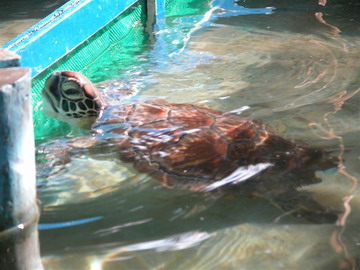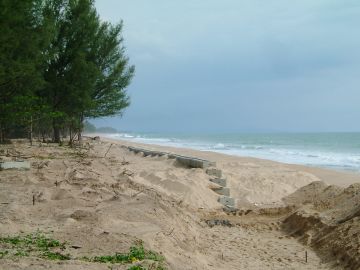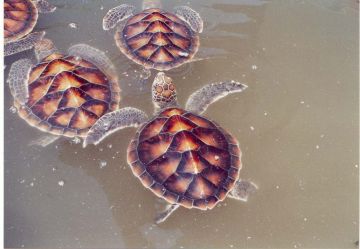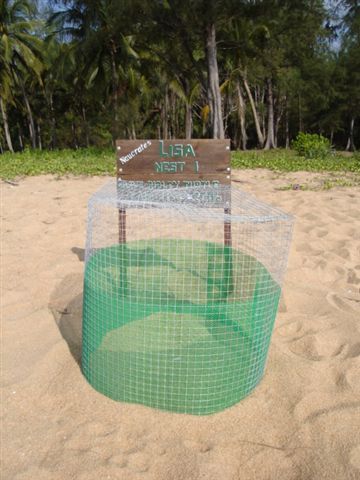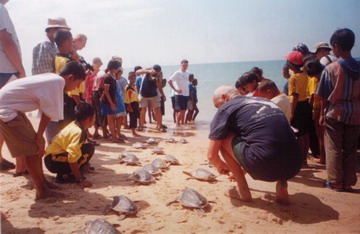Monica Aureggi
Naucrates, Onlus, Via Vorbetta, 1 - 22063 Cantù(CO) - Italy.
email: naucrates12{at}tiscali.it
Introduction
A symbol of longevity, fertility, strength and protection from harm, sea turtles are revered in culture and customs around the globe. However, sea turtles have also been exploited for their meat, eggs, shells, leather and oil for centuries. The negative effects of this unregulated adult and egg harvest, along with impacts from habitat degradation, coastal construction, commercial trade and mortalities through incidental capture in coastal and pelagic fisheries, have accelerated the decline of sea turtle populations. Today, all sea turtle species are listed as either endangered or critically endangered under the IUCN Red List.
Marine turtle populations in Asia have been depleted through long-term harvesting of eggs and adults, and as a result of being caught as by-catch in the ever growing trawler fisheries (Shanker & Pilcher, 2003). It is thought that the decline in abundance of sea turtles and other large vertebrates has initiated the collapse of the marine ecosystems in which they lived (Jackson et al., 2001). The remaining sea turtle populations in Thailand are widespread and scatter-distributed throughout the country. Although most of the available information is informal data on population status, trends and local exploitation or scientific data collected using different methodologies, it is known that sea turtles nest along the Andaman Sea coast (west coast) and in the Gulf of Thailand (east coast). Five species have been recorded in Thai waters: olive ridley turtle (Lepidochelys olivacea), green turtle (Chelonia mydas), hawksbill turtle (Erethmochelys imbricata), loggerhead turtle (Caretta caretta) and leatherback turtle (Dermochelys coriacea) (Phasuk & Rongmuangsart, 1973).
Nesting populations
The nesting area in the Gulf of Thailand is mainly identified as Khram Island, whereas the area on the West coast along the Andaman Sea includes beaches at Phra Thong island, Thai Muang National Park, the west coast of Phuket island, the Surin and Similan islands (Huyong Island) and Taru Tao National Park ( Figure 1).
Fig.1. Map of Sea Turtle Conservation sites in Thailand. Starting from the East Coast:
- Sea Turtle Conservation Station, Man Nai island, known as the ‘Queen Project’. There is a big breeding pond, build about 20 years ago. The pond is a closed area in the sea with a little nesting beach. Many nursery tanks are in the centre and head-started sea turtles are released every year from the Station.
- Sri Racha, Conservation Pond, Choburi. The Major Chatchai Timkrachang of Sri Racha Municipality and the local Municipal Council started the Conservation of sea turtles in 1992, establishing the pond. In December 2002, 59 Green turtles and 43 Hawksbill turtles, kept in the pond were released.
- Sattahip Naval Base (Rayong). The Royal Thai Navy has had a role in the protection of sea turtles since 1950. In 1992 a special task force called the Nature Sea Turtle Conservation Unit was set up. This unit is responsible for the observation of natural resources around Khram, Ira and Jang islands. They have built an education centre, and the building is in the shape of a turtle. They release 18.000 turtles every year.
- Baan Talae Nok Project.
- Ranong Biodiversity Centre.
- Conservation Project, Phra Thong island.
- Tap Lamu, Royal Thai Navy.
- Thai Muang National Park, South West coast of Thailand. Every year in March a sea turtle festival is celebrated in Thai Muang village.
- Mai Khao beach, Phuket west coast.
- Phuket Marine Biological Center, Phuket.
- Surin islands, National Park.
- Similan island, Royal Thai Navy.
- Taru Tau islands, South West coast of Thailand.
In the inner Gulf of Thailand green and hawksbill turtles are commonly found nesting on some islands, with a ratio of green turtles to hawksbill turtles of more than five to one (Monanunsap et al., 2003), during the whole year with a peak in activity from May to July (Chantrapornsyl, 1997). Data reveals that the number of green turtle nests per year fluctuated between 134 and 933 from 1983 to 2000 and that the total number of nesting female green turtles is less than 300 (Monanunsap and Charuchinda, 2001). Between 1985 and 1995 hawksbill nests ranged from 27 to 126 per year (Chantrapornsyl, 1997); an approximate estimate of between 9 and 42 hawksbill females per season can be generated by dividing the number of nests by a factor of 3, the estimated mean number of nests laid per female in any season. In reference to the same area, the Royal Thai Navy reported that 50,939 marine turtle hatchlings were released between 1995 and 1996 (Klom-in, 2001).
Olive ridley, green and leatherback turtles all nest along the Andaman Sea coast. Nesting normally occurs between October and February for olive ridleys and leatherbacks, whilst there is rare olive ridley nesting in September and March and infrequent leatherback nesting in August. Green turtles nest from March to July (Aureggi et al., 2004). Sea turtle nests recorded along the Andaman Sea coast ranged from 85 to 360 between 1985 and 1995 (Chantrapornsyl, 1997). From 1997 to 2000 a lower number of nests was observed with a total of 32, 21 and 21 at Phra Thong island, Thai Muang and Phuket respectively (Aureggi et al., 2004). At Phra Thong island and Kho Khao island nests recorded varied between 4 and 13 from 1996 to 2003; most nests belonged to the olive ridley turtle, with leatherback and green turtles nesting only occasionally (Aureggi and Chantrapornsyl, 2003). The Royal Thai Navy reported the release of 34,616 hatchlings in Phang Nga province (Andaman Sea coast) from 1995 to 2001 (Klom-in, 2001).
Although most information in the literature refers to sea turtles without specifying species, some detailed information is available for the olive ridley turtle. According to Chantrapornsyl (1992), at Phra Thong island an overall decline in olive ridley nests of 82% was recorded between 1979 (n=238) and 1990 (n=42), with a similar decrease reflected in data collected between 1996 and 2003 (Aureggi & Chantrapornsyl, 2003). The number of nesting females has probably fallen to less than 20 per year along the entire coast of the Andaman Sea. On the Surin islands (located about 50 km off the west coast of Thailand in Phang Nga Province) hawksbill and green turtle nesting occurs all year round with a peak between July and October (Chantrapornsyl, 1997). On the Similan islands (off the west coast of Thailand) green turtle nesting activity was monitored from 1995 to 2002 by the Royal Thai Navy (Klom-in, 2002).
Historical information
Despite sea turtles being protected by national law since 1947, they have been exploited year by year. Regulations for egg harvesting have been applied along nesting beaches in order to control egg poaching activities. The sea turtle nesting beaches were in fact declared concession areas by the Thai Government and licences to collect turtle eggs were given to local people who were then required to release hatchlings to the equivalent of 20% of the eggs collected (Chantrapornsyl, 1992). As a result of long term excessive egg harvesting, stocks of olive ridley and leatherback turtles in the Andaman Sea of Thailand have been decimated to only tens of females nesting annually (Limpus, 1995).
Historical data reflects a massive sea turtle egg harvest in Thailand, estimated to be about 400,000 eggs per year (Polunin, 1975). Data concerning sea turtle nesting activity shows a drastic decline (90%) of sea turtle nests on the Andaman coast (Chantrapornsyl, 1997). From 1997 to 2000 the low number of nests confirmed the same decreasing rate at Phra Thong island, Thai Muang and Phuket (Aureggi et al., 2004). A similar trend was reported at Phra Thong and Kho Khao islands from 1996 to 2004 (Aureggi et al., 2003).
At Khram island (Gulf of Thailand) the protection of sea turtles by the Royal Thai Navy since 1950 is likely to have effectively reduced the decline of the nesting population in contrast to the situation on the Andaman Sea coast.
Genetics
Low genetic divergence between the nesting green turtle populations of the Gulf of Thailand and the Andaman Sea was detected, indicating that the present geological boundary (the part of the southern continent from Thailand to the Malaysia peninsula down to Indonesia) does not effectively prevent the gene flow between the two populations that is observed in invertebrate species in these areas (Kittiwattanawong et al., 2003b).
Migration routes
Although most sea turtle populations in the South East Asian region have recently been dramatically decreasing, knowledge of feeding and foraging habitat is still scanty, whereas knowledge of migration patterns has improved in the last five years.
Two hawksbill turtles nesting in the Gulf of Thailand were tracked using satellite transmitters between February and August 2002. The tracking information showed a very restricted area of movement during the inter-nesting period: a radius of 25 km from the nesting beach (Monanunsap et al., 2003). A restricted inter-nesting distribution was also observed during 2000 to 2002, by 19 nesting green turtles tracked in the Gulf of Thailand, which showed a distribution within 6 km from their nesting islands (Kittiwattanawong et al., 2003).
Green turtle females tracked in the same area travelled long distances commencing a post-nesting migration. Eleven green turtles tracked with satellite transmitters migrated in two directions: the first route stretched eastward along the eastern coast of the Gulf of Thailand to the Vietnam peninsula, then some crossed the South China Sea and entered Sulu Sea of Philippines water; the second route went south across the Gulf of Thailand to the Malaysia peninsula travelling a distance that ranged from 456 to 2823 km (Charuchinda et al., 2003a).
An adult female loggerhead turtle accidentally captured in the Gulf of Thailand and kept in captivity for ten years was released with a satellite transmitter in the same area. The animal, which was genetically similar to Australian turtles, travelled south-eastward across the Gulf of Thailand passing the Malaysia peninsula, south Borneo island, and the Bali Sea of Indonesia and ended up off the coast of Derby in western Australia (Charuchinda et al., 2003b), indicating that Thailand might be a foraging area for this population.
Eight nesting female green turtles tracked from the Similan Islands (Andaman Sea coast) in 2001 to 2002 aggregated mainly within 27 km of the nesting island during the inter-nesting period; after nesting they travelled towards the Andaman Islands (India) (Kittiwattanawong et al., 2001).
One nesting olive ridley tracked from Phra Thong island in 2001 swam northward reaching the Margui Archipelago (Myanmar) (Aureggi, pers. comm.).
Current protective regulations
The Fisheries Act of B:E:2490 (1947) was announced by the Thai Government as a conservation measure. In accordance with this law, the killing of sea turtles is prohibited, whilst egg collecting along certain (but not all) beaches requires a yearly licence issued to concessionaires who have to hatch a fixed percentage of the eggs collected and release the baby turtles into the sea. These duties are supervised by the provincial fisheries officers (Phasuk & Rongmuangsart, 1973). In 1972 legislation prohibiting commercial fishing within 3 km of the coastline was established and in 1980 the Ministry of Commerce Enactment prohibited the export of sea turtles. Thailand signed up to CITES in 1983. In 1996 TEDs (Turtle Excluder Devices) were adopted by the Fisheries Department in both the Gulf of Thailand and the Andaman Sea. In 2004 Thailand signed the Memorandum of Understanding on the Conservation and Management of Marine Turtles and their Habitats of the Indian Ocean and South-East Asia (IOSEA MoU).
At the regional level the Association of Southeast Asian Nations (ASIAN) operates a programme on sea turtle conservation encouraging international cooperation to protect this migrating animal.
Threats to nesting areas
According to Polunin (1975) human predation was the most significant source of sea turtle mortality in Thailand. Egg poaching is the main threat at Thai Muang beach (Aureggi et al., 2004), Phra Thong island (Chantrapornsyl, 1992), Mai Khao beach, Phuket, Surin and Similan islands (Chantrapornsyl, 1997) and Baan Talae Nok (Aureggi pers. comm.). Chelonia eggs sold for 1 to 2 Baht each (about 10 cents) and Dermochelys for 5 to 8 Baht in the market (Polunin, 1975). In 1992 leatherback eggs were worth 25 Baht and other turtle eggs 16 Baht in local markets, whereas in Phuket restaurants eggs were sold for double these prices (Chantrapornsyl, 1997). In 1995 Lepidochelys eggs sold for 20 Baht each on Phra Thong island (Aureggi, pers. comm.). Although conservation and education programmes, together with national and international regulations and a decrease in the number of nests laid, have brought the end of egg poaching in a few places (Aureggi et al., 2000), it is still practised on remote beaches which are not regularly monitored by conservationists. Many Thai tropical sandy beaches are a major destination for millions of tourists throughout the year, sometimes involving turtle nesting beaches and the nesting season. Several nesting areas (e.g. Phuket island) are severely threatened by tourist development to the extent that only few and scattered nests are found. Beach protection and enhancement activities, such as cement barriers to protect beaches from erosion or tsunamis, carried out on nesting beaches (Thai Muang, Kho Khao island) provoke a negative impact on reproductive procedures and either inhibit females from nesting or increase mortality of eggs and hatchlings. The development of prawn hatcheries near beaches is also affecting turtle nesting activity by producing light and other pollution.
Mortalities at sea
Fishing activity is thought to be one of the main causes of decline in the turtle population of Thailand (Polunin, 1975; Chantrapornsyl, 1997), even though little data is available to estimate the rate of mortality. According to Polunin (1975) the rapid expansion of fishing operations is largely responsible for the increase in the killing of adult turtles over recent years, and the supply of stuffed sea turtles and tortoise-shell products which has been augmented considerably. The meat of a single large turtle was worth about 1000 Baht (50 US$) in 1975 which is a considerable amount of money considering the average daily wage was 30 Baht (1.5 US$) (Polunin, 1975). In 1973, sea turtle shells and their manufactured products, totalling 14,500 kg, were exported mainly to Hong Kong and Taiwan, with some to Singapore, Korea and Japan. By 1983, this had increased to 908,000 kg (Phasuk, 1992).
Along the Andaman Sea coast (Phang Nga, Phuket, Krabi, Trang and Satun) 214 stranded (either alive, dead or injured) hawksbill (n=157), green (n=25) and leatherback (n=4) turtles, plus two unidentified species, were recorded between 1991 and 2002; 26.2% of the stranded specimens were washed ashore by gill nets and another 7% by miscellaneous fishing gear (Adulyanukosol and Ruangkaew, 2002).
A comparison by Shiba et al. (2002) between the migration routes of adult female green turtles and the distribution of shrimp trawl fishing grounds in the Gulf of Thailand showed no overlapping, and therefore it was concluded that adult females have few chances to meet shrimp trawlers; however, these findings have yet to be confirmed and have not been substantiated by on-board studies.
Conservation and management
Conservation programmes in Thailand have existed for several decades. National institutions such as the Royal Thai Navy have played a role in sea turtle conservation in the Gulf of Thailand since 1950 and even Her Majesty the Queen showed an interest in preserving these reptiles by setting up the Queen’s Sea Turtle Conservation project on Man Nai island in 1979 (Fig.1). Because coastal lands are administered by several different agencies as well as by private individuals, there is no single standard approach to sea turtle conservation (Settle, 1995). Programmes are managed by different authorities and institutions, such as the Royal Thai Navy (Similan islands, Tap Lamu, Khram island), National Parks (Surin and Similan Islands, Thai Muang, Nyiang), the Fisheries Department (Phuket), universities (Ranong Biodiversity Center), local people (Mai Khao beach, Tarutao islands, Ko Phra Thong) and Non-Governmental Organisations (Mai Khao beach, Phra Thong islands, Baan Talae Nok).
The result is a variety of management practices and beliefs about turtle conservation. A national database does not exist and there is a lack of coordination between institutions. An example of inconsistency in conservation strategies is the practice of head-starting contrasted to releasing hatchlings immediately. Head-starting is a popular and deeply established practice in Thailand. It is strongly believed that it avoids the high mortality rate associated with hatchlings going straight into the sea after hatching, and that the number of turtles reaching sexual maturity is greater than that which occurs amongst immediately-released turtles. Many park superintendents, conservation workers and others in charge of conservation programmes lack scientific training and an understanding of basic biology; therefore head-starting is not undertaken because of any known scientific value of the technique, but rather as a strategy in which they have a deep belief. The fact that hatchlings should be allowed the opportunity to imprint their natal beaches, that conditions in head-start tanks are likely to compromise hatchling growth and that an animal must be healthy before being released into the wild are only some of the aspects that are all too often overlooked by programme managers. Although head-starting in Thailand has been carried out since about 1978 (Chantrapornsyl, 1992), meaning by now (in the year 2005) there should be an indication of its effect on the wild turtle population, there is no evidence to prove the validity or success of this conservation method. This is either because there is a lack of scientific data collection or because the head-starting technique has not achieved the expected result or indeed it is having an adverse effect.
Turtle tanks have been built in a variety of different centres (Fig.1) and hatchlings are released on different beaches from where they were born to satisfy the demand of turtle-releasing ceremonies throughout the country. In fact, it is a Buddhist belief that releasing a turtle will bring good luck and long life. There are frequently turtle-releasing ceremonies for Her Majesty the Queen’s birthday, New Year and other occasions. The impact of head-starting on the wild population cannot be estimated, but the potential negative effects should be taken into consideration when it is not carried out in an appropriate way and goes against the basic principles of keeping an animal in captivity. Monitoring programmes are carried out along some nesting beaches but very often they are not done on a regular basis and do not follow a standard methodology. Therefore the number of nests reported is more an estimation than scientific data. An exception is the sea turtle project at Phra Thong island which is always managed by the same team and has provided a scientific data set, covering eight consecutive nesting seasons (Aureggi et al., 2003).
Conservation awareness is well developed and carried out in different areas involving children and villagers. A recent book named "Ban Khong Tao Talay" (Home of Marine Turtles) in honour of Her Majesty has been published to promote the conservation of the sea and marine turtles to Thai people.
Acknowledgements
I wish to thank the British Chelonia Group for funds to purchase a video-projector that is used to carry on awareness activities in Thailand and in other countries. The author would like to thank Supot Chantrapornsyl and all the Thai colleagues for having supported sea turtle conservation in Thailand. Thanks to Katie Jones for revising the language.
References
Adulyanukosol, K. & Ruangkaew, R. (2003). Sea turtle stranding records in the Andaman coast, Thailand. In: Proceedings of the 3rd Workshop on SEASTAR2000 (Editor: Arai, N.) pp. 105–109.
Aureggi, M. & Chantrapornsyl, S. (2003). Conservation Project: sea turtles at Phra Thong Island, South Thailand. Kachhapa Newsletter 9: 3–5.
Aureggi, M., Chantrapornsyl, S. & Young, L. (2003). Conservation Project at Phra Thong and Kho Khao Islands, South West Thailand. Tiger Paper 30(3): 11–13.
Aureggi, M., Gerosa, G. & Chantrapornsyl, S. (2004). An update of sea turtle nesting along the Andaman coast of Thailand: 1996–2000. In: Proceedings 21st International Symposium on Sea Turtle Biology and Conservation (Editors: Coyne, M.S. and Clark, R.D.) pp. 98–100. NOAA Technical Memorandum NMFS-SEFSC-528.
Aureggi, M., Gerosa, G. & Chantrapornsyl, S. (2000). Elimination of egg poaching activity at Phra Thong island, Thailand. First Italian Meeting on Sea Turtle Biology and Conservation. Policoro, Italy.
Charuchinda, M., Sakamoto, W., Arai, N. & Monanunsap, N. (2003a). Migration pattern of post-nesting green turtles in the Gulf of Thailand. In: Proceedings of the 3rd Workshop on SEASTAR2000 (Editor: Arai, N.) pp. 53–57.
Charuchinda, M., Sakamoto, W., Monanunsap, N. & Arai, N. (2003b). Satellite tracking for loggerhead turtles, Caretta caretta: note on navigational ability in the ocean. In: Proceedings of the 3rd Workshop on SEASTAR2000 (Editor: Arai, N.) pp. 59–62.
Chantrapornsyl, S. (1992). Biology and Conservation Olive Ridley Turtles (Lepidochelys olivacea) in the Andaman Sea, Southern Thailand. Phuket Mar. Biol. Cent. Res. Bull. 57: 51–66.
Chantrapornsyl, S. (1997). Status of marine turtles in Thailand. Unpublished report.
Jackson, J.B.C., Kirby, M.X., Berger, W.H., Bjorndal, K.A., Botsford, L.W., Bourque, B.J., Bradbury, R.H., Cooke, R., Erlandson, J., Estes, J.A., Hughes, T.P., Kidwell, S., Lange, C.B., Lenihan, H.S., Pandolfi, J.M., Peterson, C.H., Steneck, R.S., Tegner, M.J. & Warner, R.R. (2001). Historical over fishing and the recent collapse of coastal ecosystems. Science 293: 629–638.
Kittiwattanawong, K., Chantrapornsyl, S., Mananansup, M., Charuchinda, M., Sakamoto, W., Arai, N. & Klom-in, W. (2003). Protective areas for internesting green turtle (Chelonia mydas) populations in Thailand. In: Proceedings of the 3rd Workshop on SEASTAR2000 (Editor: Arai, N.) pp. 45–48.
Kittiwattanawong, K., Mananasup, S., Kinoshita, M. & Nakayama, K. (2003b). No genetic divergence between green turtle (Chelonia mydas) nesting populations from the Andaman Sea and the Gulf of Thailand. In: Proceedings of the 4th Workshop on SEASTAR2000 (Editor: Arai, N.) pp. 15 – 19.
Kittiwattanawong, K., Chantrapornsyl, S., Sakamoto, W., & Arai, N. (2001). Feeding and inter-nesting grounds of the green turtle nesting population at Similan islands, Thailand. In: Book of abstracts of the 1st Workshop on SEASTAR2000, Phuket, 2001, p. 21.
Klom-in, W. (2001). The Royal Thai Navy sea turtles conservation in the Andaman Sea. In: Book of abstracts of the 1st Workshop on SEASTAR2000, Phuket, 2001, p. 12.
Klom-in, W. (2002). The Royal Thai Navy sea turtles conservation in the Andaman Sea. In: Book of abstracts of the 3rd Workshop on SEASTAR2000, Bangkok, 2002, p. 36.
Limpus, C.J. (1995). Global overview of the status of marine turtles: a 1995 review. In: Biology and conservation of sea turtles. Ed: Bjorndal, K.A., revised edition, 1995, Smithsonian Inst. press, Washington D.C., pp. 605–609.
Monanunsap, S. & Charuchinda, M. (2001). Reproductive biology of green turtle at Ko Kram Island, Chonburi Province, Thailand. In: Proceedings of the 1st Workshop on SEASTAR2000, pp. 11–15.
Monanunsap, S., Charuchinda, M. & Tatsukawa, K. (2003). Satellite tracking for nesting hawksbill, Erethmochelys imbricata in the Gulf of Thailand. In: Proceedings of the 3rd Workshop on SEASTAR2000 (Editor: Arai, N.) pp. 23–25.
Phasuk, B. & Rongmaungsart, S. (1973). Growth studies on the olive ridley turtle, Lepidochelys olivacea Eschscholtz, in captivity and the effect of food preference on growth. Phuket Mar. Biol. Center Res. Bull.: 114pp.
Phasuk, B. (1992) (Thai). Biology, culture technique and conservation of sea turtles in Thailand. Phuket Mar. Biol. Cent. Tech. Paper. No.1/1992: 114pp.
Polunin, N.V.C. (1975). Sea Turtles: reports on Thailand, West Malaysia and Indonesia with synopsis of data on the conservation status in the Indo west pacific region. IUCN unpubl. report.
Settle, S. (1995). The status of nesting populations of sea turtles in Thailand and their conservation. Tiger Paper 22(1): 2–6.
Shanker, K. & Pilcher, N.J. (2003). Marine turtle conservation in South and Southeast Asia: hopeless cause or cause of hope? MTN 100: 43 – 51.
Shiba, N., Arai, N., Sakamoto, W., Tubtimsang, W. & Charuchinda, M. (2002). The relationship between shrimp trawl fishing grounds and adult female green turtle in the Gulf of Thailand. In: Proceedings of the 2nd Workshop on SEASTAR2000, pp. 5– 9.
Testudo Volume Six Number Three 2006
Top


